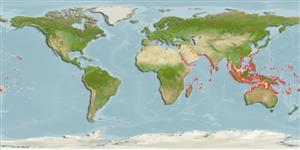>
Atheriniformes (Silversides) >
Atherinidae (Silversides) > Atherinomorinae
Etymology: Atherinomorus: Greek, atherina, the Greek name for the eperlane + Greek, moros = silly, stupid (Ref. 45335).
More on author: Forster.
Environment: milieu / climate zone / depth range / distribution range
Οικολογία
Θαλασσινό(ά); Γλυκού νερού; Υφάλμυρο Υφαλόφιλο(α); εύρος βάθους 1 - 39 m (Ref. 11897). Subtropical; 32°N - 23°S, 32°E - 154°W
Indo-Pacific: from East Africa to Tonga, north to southern Japan, and south to northern
Australia; except Andaman Sea. Replaced by Atherinomorus insularum in the Hawaiian Islands (Ref. 37816).
Μέγεθος / Βάρος / Age
Maturity: Lm ? range ? - ? cm
Max length : 25.0 cm TL αρσενικό/απροσδιόριστο; (Ref. 48635)
Ραχιαίες άκανθες (συνολικά): 5 - 8; Μαλακές ραχιαίες ακτίνες (συνολικά): 9-10; Εδρικές άκανθες 1; Μαλακές εδρικές ακτίνες: 12 - 17; Σπόνδυλοι: 43 - 44. This species is distinguished by the following characters: lateral process of premaxilla very low and wide; upper margin of the dentary almost flat distally, no distinct tubercle at the posterior end; posterior tip of the upper jaw reaching to or beyond a vertical through anterior margin of the pupil, sometimes reaching to the center of pupil; small teeth on endopterygoids, not forming obvious ridges; the anus is near or usually behind the posterior tip of the pelvic fin; lower gill rakers 18-24; midlateral scale count 40-44; lower margin of midlateral band reaching below ventral end of the midlateral (third) scale row and reaching to almost the center of the fourth scale row at level of the anal fin origin (Ref. 58474).
Common in large schools along sandy shorelines and reef margins. Reported to be mainly a nocturnal species which usually forms schools (from several hundred to more than 100 m long and 20 m wide) (Ref. 9760). Feeds mostly at night when the school disperse. Feeds on a variety of planktonic crustaceans. Preyed upon by sharks, tunas, long toms, and amberjacks which swim alongside the school. Among its other predators are crested terns, gannets, sea-gulls and herons. Slow moving and not well regarded as bait. Extremely important as forage fish for larger species (Ref. 3302). Sold fresh, or salted and dried (Ref. 12484). Minimum depth reported taken from Ref. 57178.
Life cycle and mating behavior
Γεννητική Ωρίμανση | Αναπαραγωγή | Γεννοβολία | Αβγά | Γονιμότητα | Προνύμφες
Kimura, S., D. Golani, Y. Iwatsuki, M. Tabuchi and T. Yoshino, 2007. Redescriptions of the Indo-Pacific atherinid fishes Atherinomorus forskalii, Atherinomorus lacunosus, and Atherinomorus pinguis. Ichthyol. Res. 54(2):145-159. (Ref. 58474)
IUCN Red List Status (Ref. 130435)
Threat to humans
Harmless
Human uses
αλιεία: Εμπορικό(ά); δόλωμα: usually
Περισσότερες πληροφορίες
Κοινά ονόματαΣυνώνυμαΜεταβολισμόςΘηρευτέςΟικοτοξικολογίαΑναπαραγωγήΓεννητική ΩρίμανσηΓεννοβολίαΣυναθροίσεις γεννοβολίαςΓονιμότηταΑβγάEgg development
ΑναφορέςΥδατοκαλλιέργειεςΠροφίλ υδατοκαλλιέργειαςΣτελέχοιΓενετικήElectrophoresesΚληρονομικότηταΑσθένειεςΜεταποίησηNutrientsMass conversion
Εργαλεία
Special reports
Download XML
Διαδικτυακές πηγές
Estimates based on models
Preferred temperature (Ref.
123201): 24.9 - 29.1, mean 28 °C (based on 1080 cells).
Phylogenetic diversity index (Ref.
82804): PD
50 = 0.5005 [Uniqueness, from 0.5 = low to 2.0 = high].
Bayesian length-weight: a=0.00759 (0.00428 - 0.01346), b=3.16 (3.00 - 3.32), in cm total length, based on LWR estimates for this species & (Sub)family-body (Ref.
93245).
Τροφικό Επίπεδο (Ref.
69278): 3.3 ±0.2 se; based on diet studies.
Ελαστικότητα (Ref.
120179): Μεσαίο(α), ελάχιστος χρόνος για διπλασιασμό πληθυσμού 1,4 - 4,4 έτη (Preliminary K or Fecundity.).
Fishing Vulnerability (Ref.
59153): Low vulnerability (15 of 100).
Nutrients (Ref.
124155): Calcium = 39 [17, 99] mg/100g; Iron = 0.558 [0.287, 0.992] mg/100g; Protein = 20.4 [18.0, 22.7] %; Omega3 = 0.21 [0.09, 0.51] g/100g; Selenium = 13.4 [5.8, 30.5] μg/100g; VitaminA = 70.5 [22.0, 236.9] μg/100g; Zinc = 1.18 [0.73, 1.83] mg/100g (wet weight);
